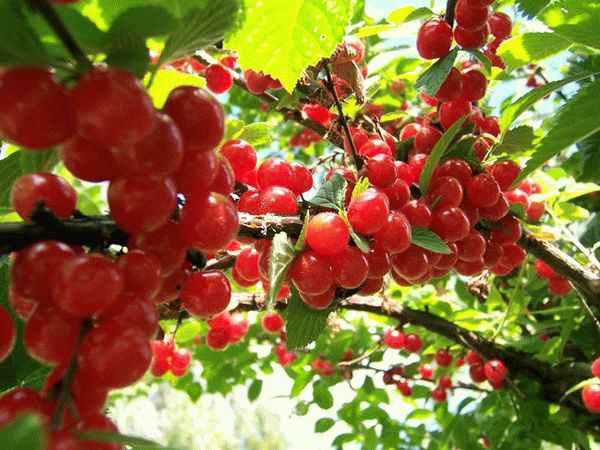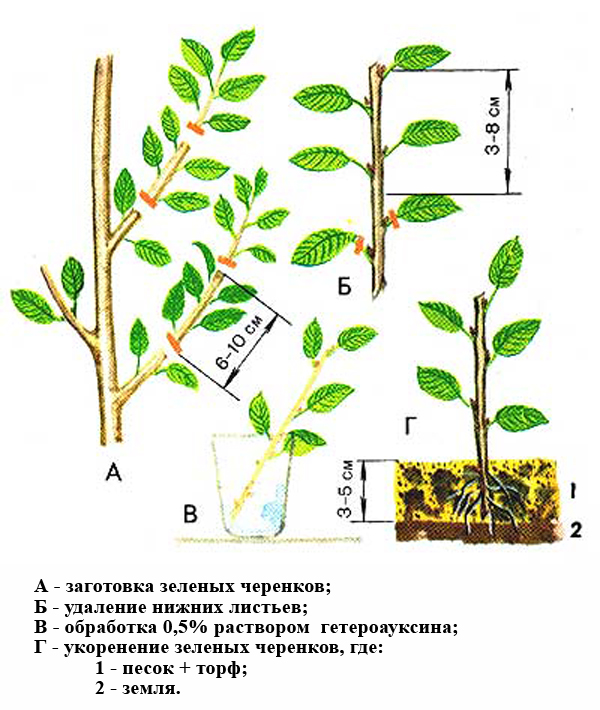Felt cherry planting rules
Having seen at least once how the felt cherry blossoms and having tasted its sweet-sour fruits, you will definitely want to have such a tree in your summer cottage. However, the planting and maintenance of felt cherry, which was originally planned and carried out with errors, can be disappointing for any gardener. After reading this article, you can easily plant the felt cherry, and also learn how to properly care for it. And then you are guaranteed an excellent berry harvest.
Content
How to plant felt cherries
Before planting, keep in mind that the felt cherry is self-fertile (it cannot self-pollinate like most fruit trees). Based on this, for better pollination, it is necessary that varieties that bloom at the same time grow nearby. For this procedure, the following varieties are better than others: "Natalie", "Fairy Tale", "Summer", "Princess".
When to plant?
It is best to plant in the spring, until the buds have blossomed on the seedling. The time period from spring to autumn will help the tree grow stronger, gain strength and prepare well for winter. It will sufficiently develop the root system and prepare reserves of nutrients. Usually planted in April. If the seedlings were prepared in advance, for their safety they should be dug in before the onset of spring. In this case, you should think about how to protect them from freezing and rodents. You can plant seedlings in the fall, but not later than September.

This variety is very adaptable, therefore it easily takes root in most areas and after two years it can delight with the first harvest. But still, there are some subtleties that you need to pay attention to while leaving.
The soil
Fertile, well-drained soils are suitable for the growth and development of this variety. Loamy and sandy loam soils are ideal in this regard, the pH reaction of which should be neutral. If the soil in your area is acidic, it will need to be limed (processed with lime). But high soil moisture will not contribute to high yields, so you should not plant a plant in lowlands. Excess moisture adversely affects the development, fruiting and immunity of the plant and may even contribute to its death.
Shallow groundwater will also interfere with the development of a young seedling. The best place for the felt cherry will be a sunny area of the garden, because it does not like shading.
Technique
To begin with, dig a hole 60 cm wide and deep. Place a fertile mixture of black soil and humus at the bottom. Fertilize the soil along the perimeter of the growth of the future tree - 1 sq. m you will need at least 3 buckets of organic fertilizers. So, potassium is taken 30 g, phosphorus - 60 g, lime - at least 800 g. The prepared mixture is thoroughly mixed until smooth.
Immediately before placing the seedling in the pit, it is advisable to cut its roots by 20-25 cm in order to promote better development of the lateral roots. After that, process the slices with a clay talker and only then start planting. Carefully monitor the depth of the root collar, it should not fall below 4 cm from the ground surface.
The distance between the trees should be at least 2 m. The layout of young seedlings should be sparse, namely 3 by 1.5 m. Do not forget to water the soil well and be sure to compact so that the bush can gain a foothold. Also mulch the soil using peat.This agronomic technique helps to maintain and regulate soil moisture, and as a result, you can reduce the number of irrigations.
Reproduction
In addition to the above-described method of planting seedlings, horizontal layers are also used for propagation. In the spring, all but one of the stems are cut off the tree. And already with the onset of summer, he will give several strong, healthy shoots, which with the arrival of the next spring will need to be cut and laid in the grooves prepared in advance. The depth to which the shoots are placed must be at least 6 cm. During the summer months, vertical young shoots will appear from them. They need periodic dusting with moist soil. Shoots that finally take root can be carefully separated from the mother tree in autumn and transplanted to a permanent place.
Reproduction can also be carried out in greenhouses using green cuttings. In the garden, they are placed in a permanent place in June, having previously prepared the soil for this, which is dug up, fertilized and mixed with a sufficient amount of sand. It is necessary to choose only those shoots, the length of which exceeds 20 cm and containing at least 4 internodes. Before planting, the ends of the cut cuttings are placed in a nutrient solution that stimulates growth (stimulants can be purchased at specialty stores for gardeners). They are kept in this solution for 12 hours and only then are they planted in the ground. Within a month, if everything is done correctly, the planted cuttings will completely take root and take root.

Reproduction of felt cherries by green cuttings
You can propagate this variety with bones. They are collected, washed and dried. In August, the dried bones must be mixed with sand or sawdust and stored until October in a cool place. After that, grooves are prepared with a depth of 3 cm and the planting material is planted there. In spring, seedlings will appear that will develop rapidly and can grow up to 50 cm in height. And already with the arrival of next spring or waiting for autumn, the shoots will definitely need to be planted.
Care after landing
After the cherry blossoms, it is necessary to fertilize with mineral nitrogen-containing fertilizers. These fertilizers should be applied along the border of the trunk circle.
Do not forget that the soil needs to be loosened regularly. It should be carried out carefully and shallowly so as not to damage the root system of the seedling. The optimum loosening depth is not more than 4 cm. In the autumn period, exclude fertilizing with nitrogen-containing fertilizers. Otherwise, the plant will release young shoots, which will die during the first frost, and with them the tree may wither.
Watering should be rational. Do not overmoisten the soil, this will adversely affect the growth, fruiting and preparation of the shrub for the winter period.
You should also pay attention to the formation of the correct shape of the bush. To do this, it is necessary to cut the seedling at a height of 40 cm. In the second year, all side branches are cut by a third. The crown of the tree needs constant monitoring. It should not be allowed to thicken, which stimulates the development of fungal diseases.
Prune branches annually to promote regular growth and abundant fruiting. Perform this procedure in the first month of spring. When pruning branches, remove diseased, deformed and old branches first. To thin out the crown, keep no more than 10 strong and healthy shoots, the rest will have to be cut off.
Always remember that if you want to grow a healthy tree, get high and high-quality yields of felt cherries, planting and caring for them must be carried out regularly and correctly. Prune the tree in time, prevent the emergence and development of diseases.
Felt Cherry Care Video
This video will show you how to care for a felted cherry.
Felt cherry, planting and caring for which is carried out correctly, after 3 years can annually produce up to 12 kg of fragrant berries from one tree. By the way, you can also use felt cherry for decorative purposes. It makes an excellent beautiful hedge.
